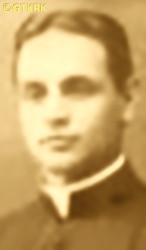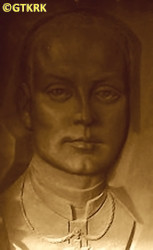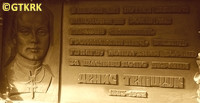Roman Catholic
St Sigismund parish
05-507 Słomczyn
85 Wiślana Str.
Konstancin deanery
Warsaw archdiocese, Poland
full list:
displayClick to display full list

searchClick to search full list by categories
wyświetlKliknij by wyświetlić pełną listę po polsku

szukajKliknij by przeszukać listę wg kategorii po polsku

Martyrology of the clergy — Poland
XX century (1914 – 1989)
personal data
surname
CIELISZCZUK
surname
versions/aliases
TELISZCZUK
forename(s)
Dennis (pl. Dionizy)
forename(s)
versions/aliases
Denis
function
eparchial priest
creed
Ukrainian Greek Catholic GCmore on
en.wikipedia.org
[access: 2013.05.19]
diocese / province
Lviv GC archeparchymore on
en.wikipedia.org
[access: 2013.05.19]
nationality
Ukrainian
date and place
of death
28.01.1952

ITL DubravLagGuLAG slave labour camp network
today: Potma, Mordovia rep., Russia
more on
en.wikipedia.org
[access: 2022.01.09]
ru.wikipedia.org
[access: 2023.11.24]
details of death
During the Polish–Ukrainian war of 1918‐1919, chaplain of the Ukrainian Galician Army UHA.
After Poland regained independence and the end of the wars over its borders in 1921, detained and arrested by the Polish authorities at least three times for radical pro–Ukrainian and nationalist activities. Among others delivered sermons in which called terrorists responsible for the murder of the Polish politician, Thaddeus Hołówko, „heroes, freedom fighters”. Imprisoned — for a period of two weeks to two years — in Lviv, Berezhany and Drohobych. The last time released in the summer of 1939, prob. in connection with the release of prisoners from Polish prisons in preparation for mobilization and war.
After the German and Russian invasion of Poland in 09.1939 and the start of World War II, after the German attack on 22.06.1941 on their erstwhile ally, the Russians, and the start of the German occupation, became a representative of the Ukrainian National Council founded by the genocidal Ukrainian OUN/UPA organization (initially, from 05.10.1941, collaborating with the Germans, but in 11.1941 dissolved by the Germans 1941 and operating clandestinely).
According to Ukrainian sources, at one point arrested by the Germans (after a search in his parish and, among other things, beating his pregnant daughter). Held in prison in Ternopil, but soon released.
After the German defeat and the beginning of another Russian occupation in 1944, arrested on 13.04.1945 by agents of the genocidal Russian NKVD organization. Held in prison in Stanislaviv.
Accused of supporting Ukrainian nationalists and collaborating with the Germans (e.g. in 1941). On 21.08.1945, tried by the NKVD military tribunal and sentenced to 10 years of forced slave labor in the Russian Gulag concentration camps.
Transported to the ITL DubravLag concentration camp in the Russian republic of Mordovia, to the Potma station. There soon fell ill (was in the camp’s „hospital” on 30.11.1949) and perished.
cause of death
extermination
perpetrators
Russians
sites and events
ITL DubravLagClick to display the description, OsobLagsClick to display the description, GulagClick to display the description, StanislavivClick to display the description, Ribbentrop‐MolotovClick to display the description, Pius XI's encyclicalsClick to display the description, Polish‐Ukrainian war of 1918‐1919Click to display the description
date and place
of birth
04.09.1885

Zavalivtoday: Pidhaitsi urban hrom., Ternopil rai., Ternopil obl., Ukraine
more on
en.wikipedia.org
[access: 2023.11.24]
presbyter (holy orders)
ordination
1911

positions held
c. 1921 – 1945
parish priest — Potiktoday: Rohatyn urban hrom., Stanislaviv/Ivano‐Frankivsk rai., Stanislaviv/Ivano‐Frankivsk obl., Ukraine ⋄ St Nicholas GC parish ⋄ Rohatyntoday: Rohatyn urban hrom., Stanislaviv/Ivano‐Frankivsk rai., Stanislaviv/Ivano‐Frankivsk obl., Ukraine
more on
en.wikipedia.org
[access: 2020.11.20] GC deanery
c. 1921 – 1945
administrator — Zalypyetoday: Rohatyn urban hrom., Stanislaviv/Ivano‐Frankivsk rai., Stanislaviv/Ivano‐Frankivsk obl., Ukraine
more on
ru.wikipedia.org
[access: 2023.11.24] ⋄ St Nicholas GC parish ⋄ Rohatyntoday: Rohatyn urban hrom., Stanislaviv/Ivano‐Frankivsk rai., Stanislaviv/Ivano‐Frankivsk obl., Ukraine
more on
en.wikipedia.org
[access: 2020.11.20] GC deanery
1918 – 1919
GC military chaplain — Ukrainian Galician Army UHA
from c. 1914
administrator — Otynevychitoday: Khodoriv urban hrom., Stryi rai., Lviv obl., Ukraine
more on
uk.wikipedia.org
[access: 2023.11.24] ⋄ Exaltation of the Holy Cross GC parish ⋄ Khodorivtoday: Khodoriv urban hrom., Stryi rai., Lviv obl., Ukraine
more on
en.wikipedia.org
[access: 2020.12.03] GC deanery
c. 1912
administrator — Nosivtoday: Pidhaitsi urban hrom., Ternopil rai., Ternopil obl., Ukraine
more on
uk.wikipedia.org
[access: 2023.11.24] ⋄ St Nicholas GC parish ⋄ Pidhaitsitoday: Pidhaitsi urban hrom., Ternopil rai., Ternopil obl., Ukraine
more on
en.wikipedia.org
[access: 2020.11.20] GC deanery
1906 – 1910
student — Lvivtoday: Lviv urban hrom., Lviv rai., Lviv obl., Ukraine
more on
en.wikipedia.org
[access: 2022.01.16] ⋄ philosophy and theology, Greek Catholic Theological Seminary
from 1910
married — eight children (three sons died during World War II, two, according to Ukrainian sources, at Polish hands)
others related
in death
CEHELSKIClick to display biography Nicholas Sava Josaphat, CZECHOWSKIClick to display biography Steven, DAWIDZIUKClick to display biography Theodore, HORCZYŃSKIClick to display biography Omelian, MARUSZCZAKClick to display biography Vladimir, OCZABRUKClick to display biography Emilian, TEODOROWICZ–POLIAŃSKAClick to display biography Mary (Sr Monica), ŻUKClick to display biography Michael
sites and events
descriptions
ITL DubravLag: Russian Rus. Исправи́тельно‐Трудово́й Ла́герь (Eng. Corrective Labor Camp) ITL Rus. Дубравный (Eng. Dubravniy) — concentration and slave forced labor camp (within the Gulag complex) — headquartered in Yavas in Republic of Mordovia. Founded on 28.02.1948, in place of ITL TemLag camp, and until 1954 also functioning as the Rus. Особый лагерь (Eng. Special camp) GULAG No. 3. Prisoners slaved at operating the Temnykovskiy industrial complex built by ITL TemLag prisoners: sewing factories, woodworking plants (e.g. furniture production), factories producing building materials (bricks, tiles, lime, building stone), railway lines, energy plants, peat extraction, wood chemical plants, etc. At its peak — till the death on 05.03.1953 of Russian socialist leader, Joseph Stalin — c. 26,000 prisoners were held there: e.g. 23,273 (01.01.1949); 23,532 (01.01.1950); 23,541 (01.01.1951); 25,616 (01.01.1952); 20,680 (01.01.1953); 16,980 (01.01.1954). Formally closed its operations in 1960, but political prisoners were held there for many years later — among them Ukrainian priests and Russian dissidents — until its final closure in the second half of the 1980s. (more on: old.memo.ruClick to attempt to display webpage
[access: 2024.04.08], archive.khpg.orgClick to attempt to display webpage
[access: 2014.09.21])
OsobLags: Pursuant to Decree No. 416‐159сс dated 21.02.1948 of the Russian government, the Russian criminal organization MVD (successor to the NKVD) issued a Decree No. 00219 of 28.02.1948 establishing a separate network of camps within the Gulag system for a „special group” of political prisoners sentenced under Art. 58 of the Penal Code (referring to „enemies of the people”, i.e. accused of treason, espionage, terrorism, etc.) Initially, the group of camps included the ITL MinLag, ITL GorLag, ITL DubravLag, ITL StepLag and ITL BerLag concentration camps. Later, the following ones were added: ITL RechLag, ITL OzerLag, ITL PeschanŁag, ITL LugLag, ITL Kamyshlag, ITL DalLag, ITL VodorazDelLag. After the death of the Russian socialist leader, Joseph Stalin, in 1953, the three largest revolts in the history of the Gulag took place there: the Norilsk Uprising, the Vorkuta Uprising and the Kengir Uprising. In c. 1954 the camps were converted into standard correctional camps. (more on: en.wikipedia.orgClick to attempt to display webpage
[access: 2024.01.26])
Gulag: The acronym Gulag comes from the Rus. Главное управление исправительно‐трудовых лагерей и колоний (Eng. Main Board of Correctional Labor Camps). The network of Russian concentration camps for slave labor was formally established by the decision of the highest Russian authorities on 27.06.1929. Control was taken over by the OGPU, the predecessor of the genocidal NKVD (from 1934) and the MGB (from 1946). Individual gulags (camps) were often established in remote, sparsely populated areas, where industrial or transport facilities important for the Russian state were built. They were modeled on the first „great construction of communism”, the White Sea‐Baltic Canal (1931‐1932), and Naftali Frenkel, of Jewish origin, is considered the creator of the system of using forced slave labor within the Gulag. He went down in history as the author of the principle „We have to squeeze everything out of the prisoner in the first three months — then nothing is there for us”. He was to be the creator, according to Alexander Solzhenitsyn, of the so‐called „Boiler system”, i.e. the dependence of food rations on working out a certain percentage of the norm. The term ZEK — prisoner — i.e. Rus. заключенный‐каналоармец (Eng. canal soldier) — was coined in the ITL BelBaltLag managed by him, and was adopted to mean a prisoner in Russian slave labor camps. Up to 12 mln prisoners were held in Gulag camps at one time, i.e. c. 5% of Russia's population. In his book „The Gulag Archipelago”, Solzhenitsyn estimated that c. 60 mln people were killed in the Gulag until 1956. Formally dissolved on 20.01.1960. (more on: en.wikipedia.orgClick to attempt to display webpage
[access: 2024.04.08])
Stanislaviv: Prison used by the Russians (in 1939‐1941 — in 06.1941, when escaping from advancing Germans, Russians perpetrated a mass murder on prison inmates — and from 1944); the Germans (in 1941‐1944); and again by the Russian occupiers after replacing Germans in 1944. Thousands of Poles were jailed there. (more on: stanislawow.netClick to attempt to display webpage
[access: 2014.01.06], stanislawow.netClick to attempt to display webpage
[access: 2014.01.06])
Ribbentrop‐Molotov: Genocidal Russian‐German alliance pact between Russian leader Joseph Stalin and German leader Adolf Hitler signed on 23.08.1939 in Moscow by respective foreign ministers, Mr. Vyacheslav Molotov for Russia and Joachim von Ribbentrop for Germany. The pact sanctioned and was the direct cause of joint Russian and German invasion of Poland and the outbreak of the World War II in 09.1939. In a political sense, the pact was an attempt to restore the status quo ante before 1914, with one exception, namely the „commercial” exchange of the so‐called „Kingdom of Poland”, which in 1914 was part of the Russian Empire, fore Eastern Galicia (today's western Ukraine), in 1914 belonging to the Austro‐Hungarian Empire. Galicia, including Lviv, was to be taken over by the Russians, the „Kingdom of Poland” — under the name of the General Governorate — Germany. The resultant „war was one of the greatest calamities and dramas of humanity in history, for two atheistic and anti‐Christian ideologies — national and international socialism — rejected God and His fifth Decalogue commandment: Thou shall not kill!” (Abp Stanislav Gądecki, 01.09.2019). The decisions taken — backed up by the betrayal of the formal allies of Poland, France and Germany, which on 12.09.1939, at a joint conference in Abbeville, decided not to provide aid to attacked Poland and not to take military action against Germany (a clear breach of treaty obligations with Poland) — were on 28.09.1939 slightly altered and made more precise when a treaty on „German‐Russian boundaries and friendship” was agreed by the same murderous signatories. One of its findings was establishment of spheres of influence in Central and Eastern Europe and in consequence IV partition of Poland. In one of its secret annexes agreed, that: „the Signatories will not tolerate on its respective territories any Polish propaganda that affects the territory of the other Side. On their respective territories they will suppress all such propaganda and inform each other of the measures taken to accomplish it”. The agreements resulted in a series of meeting between two genocidal organization representing both sides — German Gestapo and Russian NKVD when coordination of efforts to exterminate Polish intelligentsia and Polish leading classes (in Germany called «Intelligenzaktion», in Russia took the form of Katyń massacres) where discussed. Resulted in deaths of hundreds of thousands of Polish intelligentsia, including thousands of priests presented here, and tens of millions of ordinary people,. The results of this Russian‐German pact lasted till 1989 and are still in evidence even today. (more on: en.wikipedia.orgClick to attempt to display webpage
[access: 2015.09.30])
Pius XI's encyclicals: Facing the creation of two totalitarian systems in Europe, which seemed to compete with each other, though there were more similarities than contradictions between them, Pope Pius XI issued in 03.1937 (within 5 days) two encyclicals. In the „Mit brennender Sorge” (Eng. „With Burning Concern”) published on 14.03.1938, condemned the national socialism prevailing in Germany. The Pope wrote: „Whoever, following the old Germanic‐pre‐Christian beliefs, puts various impersonal fate in the place of a personal God, denies the wisdom of God and Providence […], whoever exalts earthly values: race or nation, or state, or state system, representatives of state power or other fundamental values of human society, […] and makes them the highest standard of all values, including religious ones, and idolizes them, this one […] is far from true faith in God and from a worldview corresponding to such faith”. On 19.03.1937, published „Divini Redemptoris” (Eng. „Divine Redeemer”), in which criticized Russian communism, dialectical materialism and the class struggle theory. The Pope wrote: „Communism deprives man of freedom, and therefore the spiritual basis of all life norms. It deprives the human person of all his dignity and any moral support with which he could resist the onslaught of blind passions […] This is the new gospel that Bolshevik and godless communism preaches as a message of salvation and redemption of humanity”… Pius XI demanded that the established human law be subjected to the natural law of God , recommended the implementation of the ideal of a Christian state and society, and called on Catholics to resist. Two years later, National Socialist Germany and Communist Russia came together and started World War II. (more on: www.vatican.vaClick to attempt to display webpage
[access: 2023.05.28], www.vatican.vaClick to attempt to display webpage
[access: 2023.05.28])
Polish‐Ukrainian war of 1918‐1919: One of the wars for borders of the newly reborn Poland. At the end of 1918 on the former Austro‐Hungarian empire’s territory, based on the Ukrainian military units of the former Austro‐Hungarian army, Ukrainians waged war against Poland. In particular attempted to create foundation of an independent state and attacked Lviv. Thanks to heroic stance of Lviv inhabitants, in particular young generation of Poles — called since then Lviv eaglets — the city was recaptured by Poles and for a number of months successfully defended against furious Ukrainian attacks. In 1919 Poland — its newly created army — pushed Ukrainian forces far to the east and south, regaining control over its territory. (more on: en.wikipedia.orgClick to attempt to display webpage
[access: 2017.05.20])
sources
personal:
uk.wikipedia.orgClick to attempt to display webpage
[access: 2023.11.24]
original images:
www.myheritage.plClick to attempt to display webpage
[access: 2023.11.24], vikna.if.uaClick to attempt to display webpage
[access: 2023.11.24], vikna.if.uaClick to attempt to display webpage
[access: 2023.11.24]
LETTER to CUSTODIAN/ADMINISTRATOR
If you have an Email client on your communicator/computer — such as Mozilla Thunderbird, Windows Mail or Microsoft Outlook, described at WikipediaPatrz:
en.wikipedia.org, among others — try the link below, please:
LETTER to CUSTODIAN/ADMINISTRATORClick and try to call your own Email client
If however you do not run such a client or the above link is not active please send an email to the Custodian/Administrator using your account — in your customary email/correspondence engine — at the following address:

giving the following as the subject:
MARTYROLOGY: CIELISZCZUK Dennis
To return to the biography press below:
 Click to return to biography
Click to return to biography










